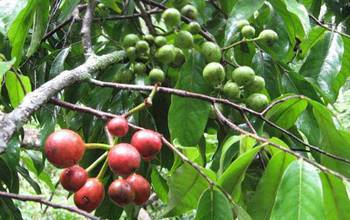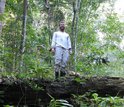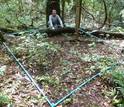Hola amigos: A VUELO DE UN QUINDE EL BLOG., hemos recibido información de la Fundación Nacional de Ciencias de Los Estados Unidos, que no dice que la caza sin piedad de los grandes animales del bosque han tenido efectos catastróficos, como por ejemplo tenemos: "El elefante ha sido durante mucho tiempo un símbolo espiritual, cultural y nacional importante en Tailandia. A principios del siglo 20, sus números superaron 100.000........
Hoy en día, esos números han caído a 2.000. Los elefantes, así como otros animales grandes, carismáticos, como los tigres, monos y gatos de algalia, están bajo el ataque de los cazadores y los cazadores furtivos..........
Hoy en día, esos números han caído a 2.000. Los elefantes, así como otros animales grandes, carismáticos, como los tigres, monos y gatos de algalia, están bajo el ataque de los cazadores y los cazadores furtivos..........
Mientras que la pérdida de estos animales es preocupante para la conservación de especies, ahora los investigadores de la Universidad de Florida han demostrado que la caza excesiva puede tener efectos generalizados en el bosque mismo.
Caza excesiva conduce a la extinción de una especie arbórea dominante, Miliusa horsfieldii, o el haya Miliusa, con efectos en cascada sobre la probable otra biota del bosque.
Los científicos informan de sus resultados en la edición actual de la revista Proceedings de la Royal Society B....................
Caza excesiva conduce a la extinción de una especie arbórea dominante, Miliusa horsfieldii, o el haya Miliusa, con efectos en cascada sobre la probable otra biota del bosque.
Los científicos informan de sus resultados en la edición actual de la revista Proceedings de la Royal Society B....................
As the animals go, so go tropical forests
 Credit and Larger Versión |
November 12, 2014
The elephant has long been an important spiritual, cultural and national symbol in Thailand. At the beginning of the 20th century, its numbers exceeded 100,000.
Today, those numbers have plunged to 2,000. Elephants, as well as other large, charismatic animals such as tigers, monkeys and civet cats, are under attack from hunters and poachers.
Overhunting of animals affects entire forest
While the loss of these animals is concerning for species conservation, now researchers at the University of Florida have shown that overhunting can have widespread effects on the forest itself.
Overhunting leads to the extinction of a dominant tree species, Miliusa horsfieldii, or the Miliusa beech, with likely cascading effects on other forest biota.
The scientists report their results in the current issue of the journal Proceedings of the Royal Society B.
Co-authors of the paper are Trevor Caughlin and Jeremy Lichstein of the University of Florida and Doug Levey, formerly of the University of Florida and now a program director in the National Science Foundation's Division of Environmental Biology.
Other co-authors are researchers at King Mongkut's University of Technology Thonburi in Thailand, Wageningen University in the Netherlands and the Royal Thai Forest Department.
Loss of one tree species has far-reaching implications
The ecologists show how vital large animals are to maintaining the biodiversity of tropical forests in Thailand.
The team looked at how these mammals contribute to moving seeds through the forest.
"It's not surprising that seed dispersers help trees get to new places," says Levey. "The effects of hunting can extend far beyond the hunted, threatening the overall health of the trees that make up the forest."
Adds Caughlin, "On the surface, it doesn't seem that seed dispersal would be important for tree populations. But seed dispersal has an effect over the whole life of a tree."
Animals critical to seed transport through the forest
The scientists looked at the growth and survival of trees that sprouted from parent trees and grew up in crowded environs, compared to trees from seeds that were widely transported across the forest by animals.
The information was supplemented with a dataset from the Thai Royal Forest Department that contains more than 15 years of data on trees.
The researchers then created a long-term simulation and ran it on the University of Florida's supercomputer, the HiPerGator.
"Having that computing power was very important," says Caughlin, "because we had to simulate the fate of millions of seeds."
The scientists discovered that trees that grow from seeds transported by now-overhunted animals are hardier and healthier.
"Our study is the first to quantify the decades-long effects of animal seed dispersal across the entire tree life cycle, from seeds to seedlings to adult trees," says Lichstein.
Probability of tree extinction increased tenfold
The results show that loss of animal seed-dispersers increases the probability of tree extinction by more than tenfold over a 100-year period.
"The entire ecosystem is at risk," says Caughlin.
"We hope the study will provide a boost for those trying to curb overhunting," he says, "and provide incentives to stop the wildlife trade."
| -- | Cheryl Dybas, NSF (703) 292-7734 cdybas@nsf.gov |
| -- | Gigi Marino, University of Florida (352) 294-3393 gigimarino@ufl.edu |
NSF Discovery: Seeing the Forest for the Trees: Seed Dispersal, Environmental Conditions Matter in African Forests:
http://www.nsf.gov/discoveries/disc_summ.jsp?cntn_id=127949&org=NSF
NSF Discovery: Landscape Corridors Provide Pathway for Seed Dispersal: http://www.nsf.gov/news/news_summ.jsp?cntn_id=104277
NSF Discovery: Border crossing: 10 things to know about invasive fire ants on the march: http://www.nsf.gov/discoveries/disc_summ.jsp?cntn_id=132165&org=NSF
NSF Award: Spatial Ecology and Evolution: Quantitative Training in Biology, Statistics, and Mathematics:
http://www.nsf.gov/awardsearch/showAward?AWD_ID=0801544&HistoricalAwards=false
An Asian black bear photographed by a camera-trap; the overhunted bears disperse tree seeds.
Credit and Larger Version

A full-grown adult Thai forest study tree; the trees are threatened by overhunting of animals.
Credit and Larger Version

Researcher surveying the tropical forest at the Huai Kha Khaeng Wildlife Sanctuary in Thailand.
Credit and Larger Version

Thousands of seedlings were tagged to learn how trees and seed-disperser animals interact.
Credit and Larger Version

One of countless tree seedlings growing in the understory of the Thai tropical forest.
Credit and Larger Versión
The National Science Foundation (NSF)
Guillermo Gonzalo Sánchez Achutegui
ayabaca@gmail.com
ayabaca@yahoo.com
ayabaca@hotmail.com
Inscríbete en el Foro del blog y participa : A Vuelo De Un Quinde - El Foro!

No hay comentarios:
Publicar un comentario